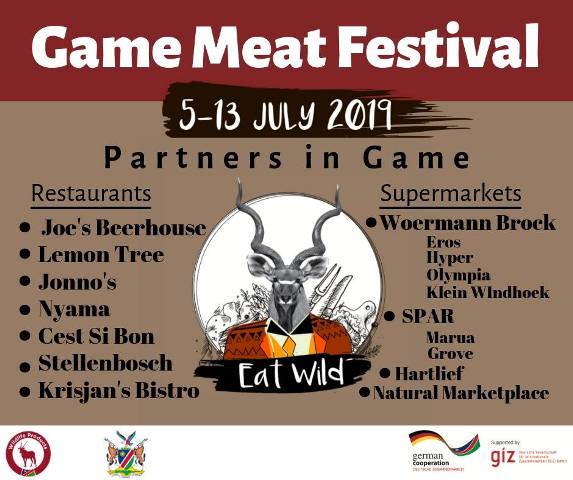 Namibia government ad for Game Meat Festival on Facebook
Namibia government ad for Game Meat Festival on Facebook
The extraordinary announcement by Namibia’s environment ministry that it was auctioning 1,000 wild animals has put a spotlight on the devastating drought gripping the country again. President Hage Gingob declared the third state of emergency in six years, after rains failed again in the southern Africa country. Netumbo Nandi-Ndaitwah, deputy prime minister, said it was Namibia’s driest year since 1929 and Windhoek had received the lowest rainfall since records began in 1891, the New Era newspaper reported.
The Global Drought Observatory (GDO) linked the drought to the El Niño climate phenomenon, which the United Nations’ Food and Agriculture Organization warned would leave more than 10.5 million people in southern Africa in ‘crisis and emergency levels of food insecurity’. The GDO said: ‘The situation is concerning especially for Namibia and Angola, where the three-month outlook shows strong and enduring drought conditions.’ It added that the expected drought conditions were ‘wiping out chances of recovery before entering the dry season’.
The animals for sale includes 600 buffalos, 150 springbok, 65 oryx, 60 giraffes, 35 eland, 28 elephants, 20 impala and 16 kudus. They would all be from national parks, the cabinet announced, with the aim of raising $1.1m to go towards wildlife conservation, Agence France-Presse reported.
An agriculture ministry report on ‘very poor’ crop prospects and food security said nearly 65,000 livestock, mainly cattle, goats and sheep, had died in the six months to April. The report described ‘unprecedented rainfall patterns’ of a two-month delay before they began followed by ‘sporadic and erratic’ rains interspersed with lengthy hot, dry spells. Total cereal production is expected to be down 53% on last year’s harvest at best, worsening already precarious food security after alternate dry spells and floods last year. The poor harvest is expected to be further exacerbated by infestations of fall armyworm – an invasive American pest that only reached Africa in 2016.
Rivers had dried up in the north and people were relying on the government for food and water, the BBC reported. Latest figures on water levels revealed that the six major dams were 34% full on average with one already dry. The government announced a drought-relief package of N$573m ($40m) for food aid, water tanks and to move livestock for grazing. Even in a good year, the sparsely populated country imports about 70% of its food from neighbouring South Africa. The prime minister, Saara Kuugongelwa-Amadhila, appealed for international assistance, telling the national assembly: ‘We … call on all Namibians and development partners to assist in any way possible.’ Private aid schemes set up by big landowners have tried to help but, as New Era reported, after providing relief to 221 small farmers and 95,000 livestock, one rancher near Windhoek, Henriette Le Grange, said the cost of fodder and fuel to distribute it meant ‘we might have reached the bottom of the well with funds drying up.’
Wild animals are not the only natural resource that Namibia is looking to sell. Along with Zimbabwe, Botswana, Zambia and Angola, it renewed calls last month for the ban on trading ivory to be lifted. Geingob said Namibia faced an unprecedented human-wildlife conflict and it ought to be able to sell ivory, ‘so it benefits the communities.’ However, it remains to be seen how wisely such funds might be spent. Namibia’s state-owned Game Products Trust Fund, which would administer proceeds of the wild animals sale, had no details of any projects it has worked on since it was set up in 1997. The GPTF was contacted for comment but had not responded by the time of publication.



